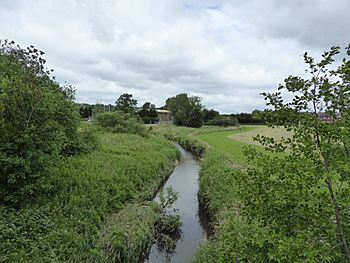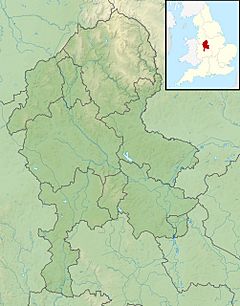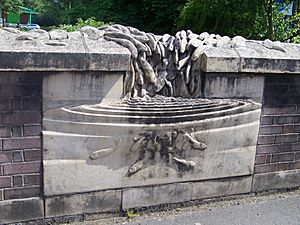Lyme Brook facts for kids
Quick facts for kids Lyme Brook |
|
|---|---|

Lyme Brook from the A500
|
|
|
Lyme brook within Staffordshire
|
|
| Country | England |
| Counties | Staffordshire |
| Physical characteristics | |
| River mouth | Hanford, Staffordshire 52°58′44″N 2°12′11″W / 52.979°N 2.203°W |
| Length | 4.1 km (2.5 mi) |
| Basin features | |
| Basin size | 31 km2 (12 sq mi) |
| Progression : Lyme Brook—Trent—Humber | |
The Lyme Brook is a small river, also called a stream. It flows through Newcastle-under-Lyme and parts of Stoke-on-Trent in Staffordshire, England. This brook is a tributary of the River Trent. A tributary is a smaller stream or river that flows into a larger one.
Contents
Where Does Lyme Brook Flow?
The Lyme Brook starts its journey north of Newcastle. Over the years, many parts of the brook have been covered up or built over. This means you can only see certain sections of it today.
Joining Other Streams
South of Newcastle town centre, the Lyme Brook meets other smaller streams. These include the Silverdale and Ashfield brooks. This area was very important a long time ago. In the 12th century, the water from these brooks was used to create a protective pool. This pool was around a special type of castle called a motte-and-bailey castle. The town of Newcastle-under-Lyme actually got its name from this new castle and the pool!
Its Path to the Trent
From the Pool Dam area, the Lyme Brook is known as a "main river." This means it's managed by a special authority because it's important for flood control. It flows south-east through a narrow valley. This valley is between areas called Clayton and Trent Vale. Here, the brook forms the border between Newcastle and Stoke.
The brook then passes by the Clayton Wood Training Ground. It goes under the A500 dual carriageway. Finally, it joins the larger River Trent near a place called Hanford. The area that collects water for the Lyme Brook is called its drainage basin. This basin covers about 31 square kilometers (12 square miles).
Flooding and Protection
Sometimes, the Lyme Brook can cause flooding. To help prevent this, a special project was done in the 1990s. This was a flood protection plan.
The Return Sculpture
After the flood protection project was finished, a sculpture was made to celebrate it. This sculpture is called The Return. It's located on the Brook Lane bridge. The artist, Ian Randall, carved it from stone in 1995. It shows fish swimming back into the brook, symbolizing the return of healthy life after the improvements.
Flood Warnings
There is a flood warning service for the Lyme Brook. This service helps tell people if their homes or areas are at risk of flooding. Places like Brook Lane, Hatrell Street, and the Lyme Valley sports fields are included in these warnings.
Water Quality and Wildlife
Like many rivers in the Potteries area, the Lyme Brook faced pollution problems. This happened as the area grew during the Industrial Revolution. For example, sewage from Newcastle used to flow directly into the brook. Later, sewage treatment plants were built. This helped a lot, but some problems still remained.
Ecological Health
Today, the Lyme Brook's water quality is still not as good as it could be. It's currently rated as having "bad ecological quality." This is the lowest rating on a special scale used to measure river health. This scale goes from high, good, and moderate, down to poor, and finally bad. The main issues are still poor water quality and not enough aquatic (water-living) plants and animals. Efforts are ongoing to improve the health of the brook.



